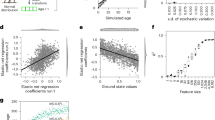Abstract
SINCE Swim and Parker1 and Hayflick and Moorhead2 documented the limited life span of diploid human fibroblasts in cell culture, many investigators have used these cells as possible models of cellular senescence. Most normal human fibroblasts exhibit marked cellular changes and eventually cease growth after fifty to seventy cell divisions. Hayflick3 and Martin et al.4 demonstrated an inverse relationship between the life span of cultured human diploid fibroblasts and the age of the donor. Furthermore, fibroblasts from children with premature ageing diseases have a markedly reduced potential for cell division4. Many investigators have studied human fibroblasts to determine whether their finite life span is related to ageing, and to determine the mechanism of ‘senescence’ in these cells5. There is no firm evidence, however, that fibroblast ‘ageing’ or limited fibroblast division potential is necessarily involved in the tissue and organ changes associated with ageing of individuals. Many types of cells which are obviously important in ageing of the whole organism undergo little or no division in adults (for example, neurones), and others which divide rapidly (for example, intestinal epithelium) have not been shown to behave as fibroblasts do, either in culture or in the organism.
This is a preview of subscription content, access via your institution
Access options
Subscribe to this journal
Receive 51 print issues and online access
$199.00 per year
only $3.90 per issue
Buy this article
- Purchase on Springer Link
- Instant access to full article PDF
Prices may be subject to local taxes which are calculated during checkout
Similar content being viewed by others
References
Swim, H. E., and Parker, R. F., Am. J. Hyg., 66, 235 (1957).
Hayflick, L., and Moorhead, P. S., Expl Cell Res., 25, 585 (1961).
Hayflick, L., Expl Cell Res., 37, 614 (1965).
Martin, G., Sprague, C., and Epstein, C., Lab. Invest., 23, 86 (1970).
Holeĉkova, E., and Cristofalo, V. J., eds., Ageing in Cell and Tissue Culture (Plenum, New York, 1970).
Orgel, L. E., Proc. natn. Acad. Sci. U.S.A., 49, 517 (1963).
Holliday, R., and Tarrant, G. M., Nature, 238, 26 (1972).
Lewis, C. M., and Tarrant, G. M., Nature, 239, 316 (1972).
Cartwright, B., Smale, C. J., Brown, F., and Hull, R., J. Virol., 10, 256 (1972).
Baltimore, D., Eggars, H. J., Franklin, R. M., and Tamm, I., Proc. natn. Acad. Sci. U.S.A., 49, 843 (1963).
Loddo, B., Boll. Soc. ital. biol. Sper., 37, 395 (1961).
Crowther, D., and Melnick, J. L., Virology, 15, 65 (1961).
Holland, J. J., and McLaren, L. C., J. Bact., 78, 596 (1959).
Author information
Authors and Affiliations
Rights and permissions
About this article
Cite this article
HOLLAND, J., KOHNE, D. & DOYLE, M. Analysis of Virus Replication in Ageing Human Fibroblast Cultures. Nature 245, 316–319 (1973). https://doi.org/10.1038/245316a0
Received:
Revised:
Published:
Issue Date:
DOI: https://doi.org/10.1038/245316a0
Comments
By submitting a comment you agree to abide by our Terms and Community Guidelines. If you find something abusive or that does not comply with our terms or guidelines please flag it as inappropriate.



